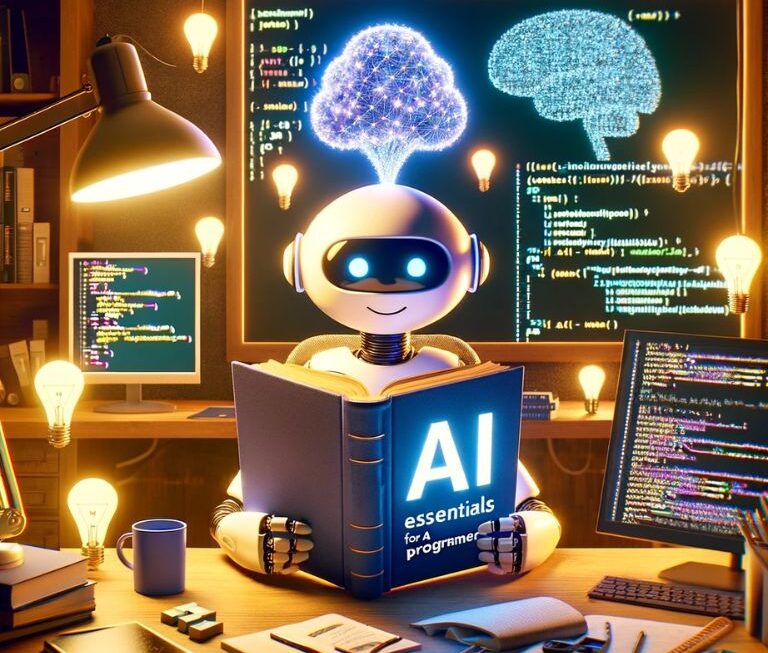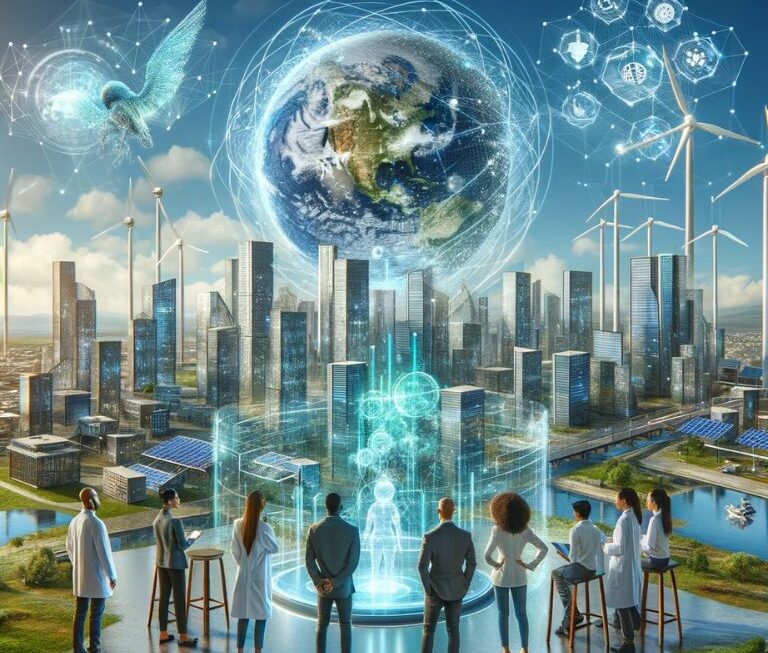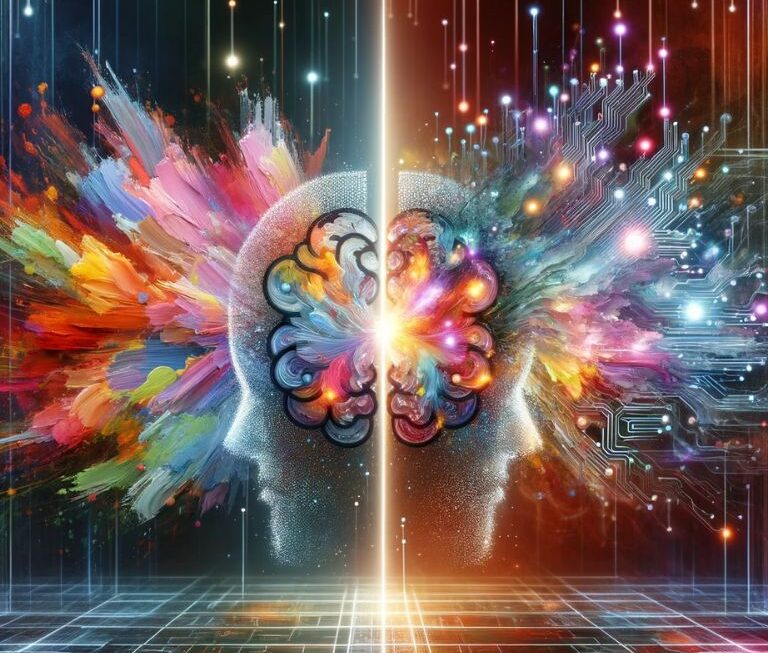The advent of Generative AI represents a seismic shift in the economic landscape, offering unprecedented opportunities for innovation, efficiency, and the birth of new business models. This technology, which encompasses algorithms capable of generating new, unique content based on learned patterns and data, is not just a tool for automation; it’s a catalyst for a comprehensive economic transformation.
Understanding Generative AI
Generative AI refers to a subset of artificial intelligence technologies that learn from existing data to create new content—ranging from text and images to strategies and solutions. This includes machine learning models like Generative Adversarial Networks (GANs) and Variational Autoencoders (VAEs), which have been pivotal in advancing fields such as natural language processing, computer vision, and more.
| Aspect | Description |
| Efficiency | Generative AI has a substantial impact on efficiency. In manufacturing and logistics, it optimizes production lines and supply chains, reducing costs and time-to-market. In services, such as healthcare and customer support, it provides personalized and efficient solutions, elevating customer experiences and satisfaction. |
| Innovation | Generative AI contributes significantly to innovation. By analyzing vast datasets, it uncovers patterns and opportunities imperceptible to humans, resulting in groundbreaking products and services. This not only empowers existing businesses but also paves the way for the emergence of entirely new industries. |
The Potential Global Impact
Generative AI’s potential extends globally, poised to transform trade through more efficient production and innovative solutions to challenges like climate change and healthcare. Yet, this power demands responsibility. Ethical AI use, data privacy, and workforce considerations must be addressed with balanced regulation and education to ensure equitable benefits. As we enter this new era, embracing Generative AI means understanding its possibilities and harnessing it for the greater good. The following sections will explore how Generative AI is leaving its mark in specific areas, showcasing its profound impact on our economic future.
Innovation Unleashed: Generative AI in Research and Development
How AI is Accelerating R&D Processes
Generative AI is revolutionizing the field of research and development (R&D) by significantly accelerating the pace at which new discoveries are made. Traditional R&D often involves a lengthy process of hypothesis formulation, experimentation, and analysis. Generative AI, however, can rapidly process vast datasets, identify patterns, and propose hypotheses or solutions, thereby compressing years of research into mere months or even weeks. This acceleration is crucial in fields like pharmaceuticals, where reducing the time to market for new drugs can have life-saving implications. Moreover, AI’s predictive capabilities are being used to simulate experiments and outcomes, leading to more efficient resource utilization and reduced costs in R&D projects.
Illustrative Examples of Innovations Powered by AI
Generative AI is making significant strides in drug discovery, with companies like Atomwise using AI algorithms to predict how chemical compounds interact with specific human body targets. This approach has uncovered potential treatments for previously challenging diseases like Ebola and multiple sclerosis. Additionally, materials science is witnessing AI-driven innovation, where AI identifies materials with desired properties by training on known materials databases. This has led to the discovery of new, lightweight yet robust materials, with the potential to transform industries by offering efficient, sustainable, and cost-effective alternatives.
Revolutionizing Manufacturing: Efficiency and Customization
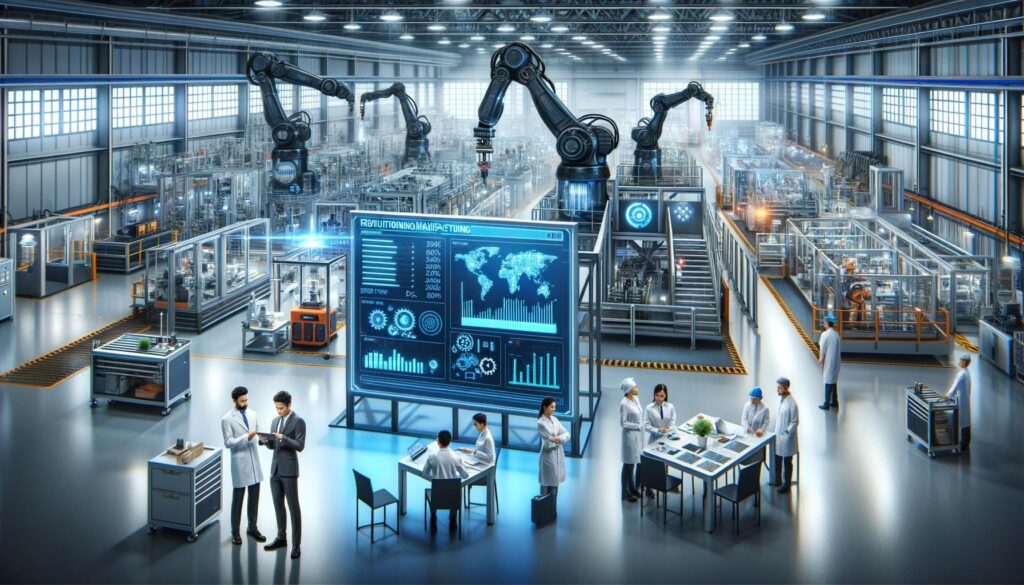
Generative AI in Enhancing Production Efficiency
Generative AI is revolutionizing manufacturing, boosting efficiency and productivity. It optimizes supply chains, automates production lines, and predicts bottlenecks through data analysis. AI suggests resource allocation and improves quality control, even predicting machine maintenance for minimal downtime. AI-driven robotics handle repetitive tasks, allowing human workers to focus on creativity. This accelerates production and lowers errors and operational costs.
Customization Possibilities in Manufacturing
Generative AI is also unlocking new levels of customization in manufacturing, catering to the growing consumer demand for personalized products. Here’s how:
- Customized Design: AI creates unique product designs based on customer preferences, especially in fashion and furniture.
- Personalized Production: AI allows efficient manufacturing of small, customized product batches without major process changes.
- On-demand Manufacturing: Generative AI enables production only when necessary, reducing inventory costs, ideal for automotive and aerospace industries.
- Supply Chain Optimization: AI optimizes the supply chain to match custom production schedules, ensuring timely material availability and product delivery.
The Service Industry Transformation: AI-Driven Customer Experiences
Impact on Retail, Healthcare, and Other Service Industries
Generative AI is revolutionizing retail, healthcare, and hospitality, elevating customer experiences. In retail, AI analyzes data, offering personalized shopping and optimizing inventory. Healthcare benefits from personalized medicine, predictive diagnostics, and better patient care. Hospitality excels with personalized rooms, activity suggestions, and efficient operations. These changes boost responsiveness, efficiency, and customer satisfaction, setting higher standards for service industries.
Examples of Improved Customer Experiences
- Personalized Shopping Recommendations: Retail AI analyzes shopping habits to enhance the customer experience and boost sales.
- Predictive Healthcare: AI predicts health issues for preventative care and better health management.
- Customized Travel Plans: AI creates tailored travel itineraries based on preferences, simplifying trip planning.
- Automated Customer Service: AI chatbots provide 24/7 support in various industries, improving response times and satisfaction.
- Smart Home Tech: AI in real estate and hospitality adjusts settings based on resident preferences for enhanced living experiences.
Emerging Business Models: Opportunities and Challenges
New Business Models Enabled by Generative AI
Generative AI is not only enhancing existing business models but also paving the way for entirely new ones. Here are some key areas where these new models are emerging:
- AI-as-a-Service (AIaaS): Companies are offering AI technologies as a service, allowing businesses to integrate advanced AI capabilities without the need for in-house expertise.
- Custom Content Creation: Businesses are utilizing AI for creating personalized content, ranging from marketing materials to personalized entertainment, catering to individual user preferences.
- Data Monetization Platforms: Organizations are leveraging AI to analyze and monetize data, providing insights and predictions as a service to other businesses.
- Automated Design and Prototyping: In sectors like architecture and product design, AI is enabling rapid prototyping and design, reducing development time and costs.
- Personalized E-commerce Experiences: Online retailers are using AI to offer highly personalized shopping experiences, with recommendations and services tailored to individual consumer behaviors.
Addressing Challenges such as Ethical Concerns and Workforce Impact
Generative AI offers vast opportunities but also presents notable ethical and workforce challenges. Ethical concerns encompass biases in AI algorithms, data privacy issues, and misuse potential. Collaboration between businesses and regulators is essential to establish ethical guidelines, ensuring fairness, transparency, and user privacy. Workforce impact is a significant concern, with automation risking job displacement. However, it also offers a chance for transformation through retraining and upskilling, nurturing skills like creativity and problem-solving that AI cannot replicate. Addressing these issues enables businesses to fully leverage Generative AI while adopting it sustainably and ethically.
The Evolution of Employment in the Age of AI and Automation
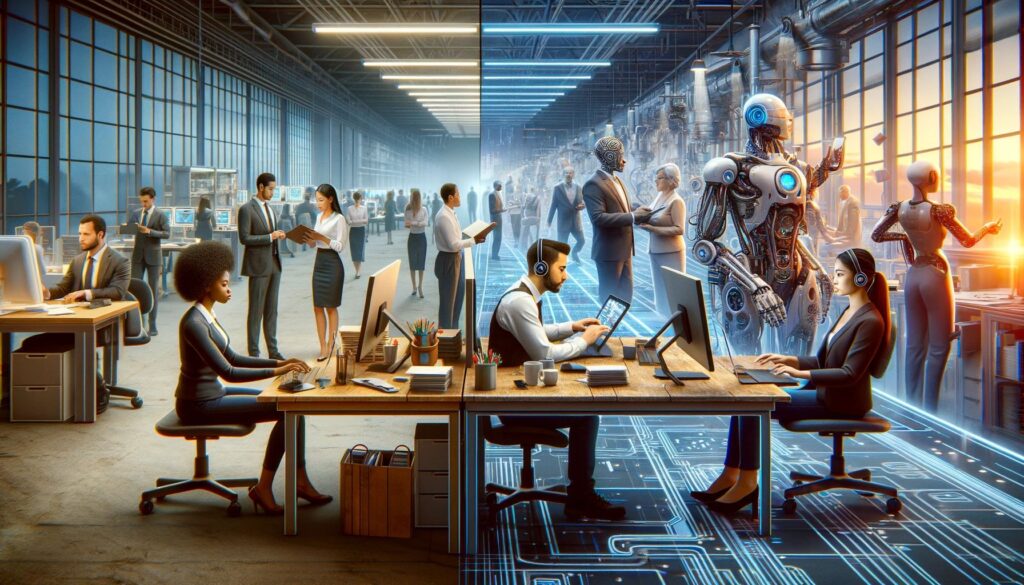
The Changing Nature of Work in an AI-Driven Economy
AI and automation integration is reshaping work across industries. Routine tasks are automated, leading to role changes. It’s not just job displacement but a shift towards roles that demand creativity, strategy, and interpersonal skills, where humans excel. New AI-driven sectors are creating fresh job categories, transforming employment in unforeseen ways.
Strategies for Workforce Adaptation and Skills Development
To successfully navigate this shift, both businesses and employees need to focus on strategies for workforce adaptation and skills development:
- Lifelong Learning: Promote ongoing skill acquisition, focusing on digital literacy and AI-related fields.
- Soft Skills Emphasis: Highlight the importance of critical thinking, creativity, and emotional intelligence alongside technical skills.
- AI Collaboration: Train employees to work effectively with AI for enhanced productivity and innovation.
- Career Transition Programs: Develop initiatives to support workers shifting into emerging roles, especially those affected by automation.
- Government-Education Partnerships: Foster collaborations among businesses, governments, and educational institutions for future-aligned training programs.
- Entrepreneurial Mindsets: Encourage entrepreneurial thinking in an AI-driven work environment, enabling innovation and new solutions.
Global Economic Impacts: A Broader Perspective
Effects on Global Trade and Economic Inequality
Generative AI’s influence extends far beyond individual industries, reshaping global trade dynamics and impacting economic inequality. Here are some of the key effects:
- Shifts in Global Supply Chains: AI-driven automation and predictive analytics are enabling more efficient and resilient supply chains, potentially shifting the balance of global trade.
- Emergence of New Global Markets: AI technologies are creating new markets and sectors, offering developing countries opportunities to leapfrog traditional industrialization paths.
- Impact on Labor Markets: Automation may lead to job displacement in some sectors, exacerbating income inequality, unless offset by new job creation and retraining programs.
- Increased Efficiency and Lower Costs: AI-driven processes are reducing production and operational costs, potentially leading to lower prices for consumers worldwide.
- Digital Divide Amplification: The unequal distribution of AI technology and expertise could amplify the digital divide, impacting less technologically advanced economies.
Anticipated Economic Changes Resulting from AI Advancements in the Future
Looking ahead, here are some predictions for how AI might further influence global economic landscapes:
- Rise of AI-Driven Economies: Economies that effectively integrate AI into their industries are likely to see significant growth and competitive advantages on the global stage.
- New Forms of Employment: The evolution of AI will likely lead to the creation of new job categories, particularly in AI maintenance, development, and ethical governance.
- Increased Need for Global Cooperation: As AI’s impact transcends borders, there will be a growing need for international cooperation on standards, ethics, and regulations.
- Acceleration of Innovation Cycles: AI’s ability to rapidly process and analyze data will likely lead to faster innovation cycles across industries.
- Redefinition of Economic Policies: Governments will need to redefine economic policies, focusing on education, technology infrastructure, and social safety nets to adapt to an AI-driven economy.
Conclusion: Navigating the AI-Driven Economic Landscape
Generative AI is profoundly reshaping the global economy by revolutionizing manufacturing, enhancing customer experiences, and accelerating innovation in research and development. This transformative power calls for adaptive strategies and ethical considerations. While Generative AI is a driving force in economic growth and trade patterns, it also presents challenges related to workforce impact and economic inequality. Embracing this AI-driven era requires responsible and equitable harnessing of its potential. The future of AI in economics is about creating a sustainable, inclusive, and ethically grounded framework that fosters innovation while safeguarding human values and societal needs.


